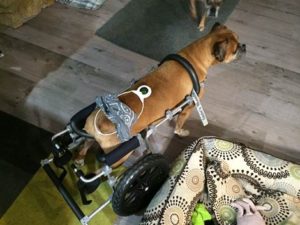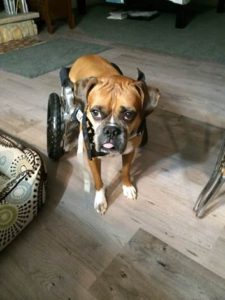Johnna Smith, DVM
Johnna Smith, DVM, on her patient Max Harris:
Max is a 7-year-old male neutered boxer that presented to me initially for alternative therapy for right hind limb weakness. After several sessions and a salivary test, it was determined that Max was, unfortunately, suffering from degenerative myelopathy. Along with acupuncture and physical rehabilitation, Mr. and Mrs. Harris came to me with the idea of adding the Assisi Loop™ to his therapy. Max tolerates his treatments with the Loop very well and seems to be more comfortable now that this is a part of his therapy. It is a great addition that can be used at home, where Max is most comfortable.
Dr. Smith works with Max through Veterinary Alternatives in Ohio.
Wendy and Richard Harris are true boxer lovers. In 2008, they had one boxer already – Tracie – but decided that it was time to add another to the family. With the help of the Greater Ohio Boxer Rescue, the Harrises welcomed Max to the family.
“He had a great foster home, but he still had a long way to go,” Wendy says of newly-adopted Max. “He had nutritional rickets, infections in his paws and his ears, he was still on the malnourished side, his back was swayed. He was not terribly coordinated. After we got him, it was a while of medicating and getting him to trust us and getting into a routine.”
Once Max fell into that routine, however, things were really looking up. He was a happy dog with his owners and boxer “sister” Tracie. The Harrises even moved to a house on 10 acres with a large yard for the dogs to race around in.
In March 2012, Max developed a cyst on his hind right paw. It was a routine removal, but as Max’s foot healed, he never stopped limping.
Richard remembers, “I wondered if they left a staple or something in there. He seemed pretty good, but he just had a little twist [in his right hind leg]. So my wife took him to the vet to look at his foot… and it wasn’t his surgery, it was the onset of degenerative myelopathy.”
Degenerative myelopathy (DM) is a disease affecting the spine, which causes progressive paralysis. It usually affects the hind region  and tends to affect breeds such as German Shepherds, the Pembroke Welsh Corgi, and Boxers such as Max. The most telling symptom of DM is ataxia (poor balance), usually originating in the hind legs.
and tends to affect breeds such as German Shepherds, the Pembroke Welsh Corgi, and Boxers such as Max. The most telling symptom of DM is ataxia (poor balance), usually originating in the hind legs.
Max’s DM did indeed present first in his hind leg, but it affected a vertebra just above his tail. Richard says of Max’s DM, “It just continued to progress over the summer. He could still run, he could still walk, but there would be a little twist. And then he started getting weakness in his right leg. He went downhill pretty fast. I would say in a matter of three months he went from being almost totally normal to not being able to use [his hind right leg].” The weakness then affected his hind left leg, until Max had trouble standing without “wobbling.”
In addition to treating Max with physical therapy and acupuncture, the Harrises began researching other alternative treatments. That’s when they came across the Assisi Loop.
 “There’s a lot of snake oil out there, and nothing of it is based on science. There’s a lot of scams, a lot of false hope,” Richard says. “So, I was a little skeptical, but [Assisi Animal Health has] some scientific literature and research to back up its claims, and the Loop requires a veterinary prescription. We talked to our vet and she looked into it and she said, ‘You know, it’s not going to hurt him – let’s see if the therapy helps.’ … It was definitely worth a shot.”
“There’s a lot of snake oil out there, and nothing of it is based on science. There’s a lot of scams, a lot of false hope,” Richard says. “So, I was a little skeptical, but [Assisi Animal Health has] some scientific literature and research to back up its claims, and the Loop requires a veterinary prescription. We talked to our vet and she looked into it and she said, ‘You know, it’s not going to hurt him – let’s see if the therapy helps.’ … It was definitely worth a shot.”
Once the Harrises started using the Loop, “he seemed a lot happier. He’s been much more animated since he’s been on it,” Richard says. “Max can tell when it’s done. You can’t feel anything, but he’s sensitive enough to it to where he knows, as soon as it goes off, he comes over to me and is like, ‘Okay, take me out of my chair now.’ … He seems to have a lot more sensitivity in his whole back end since we started using the Loop. It didn’t restore everything, but he can tell that there’s something there.”
Overall, Max is a happy dog whose bodily limitations don’t keep him from showing how thrilled he is when his owners get home.
“We used to call him the Jellybean,” Richard describes, “because he would wag so hard, his tail and his head would be at the same spot in space, one side to the other. He can’t do that now, but now he’ll sit on the ground and pull himself in one direction – like, spin – and then spin the other way.”
As of May 2015, Max continues to use the Assisi Loop and has had no further progression of DM. “We hope to hold him here indefinitely,” Richard writes.
The Assisi Loop is an excellent treatment for all types of inflammation, from arthritis to neurological issues like Max’s. If you think your pet has a condition that may be helped by the Loop, feel free to contact Assisi Animal Health with any questions.
